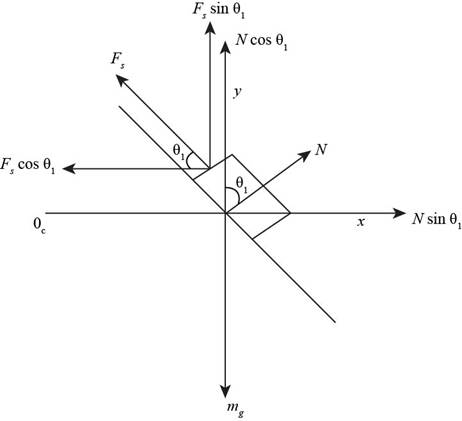
Concept explainers
(a) A luggage carousel at an airport has the form of a section of a large cone, steadily rotating about its vertical axis. Its metallic surface slopes downward toward the outside, making an angle of 20.0° with the horizontal. A piece of luggage having mass 30.0 kg is placed on the carousel at a position 7.46 m measured horizontally from the axis of rotation. The travel bag goes around once in 38.0 s. Calculate the force of staticfriction exerted by the carousel on the bag. (b) The drive motor is shifted to turn the carousel at a higher constant rate of rotation, and the piece of luggage is bumped to another position, 7.94 m from the axis of rotation. Now going around once in every 34.0 s, the bag is on the verge of slipping down the sloped surface. Calculate the coefficient of static friction between the bag and the carousel.
(a)
The force of static friction exerted by the carousel on the bag.
Answer to Problem 6.47AP
The force of static friction exerted by the carousel on the bag is 106 N up the incline.
Explanation of Solution
Given info: The metallic surface of a luggage carousel slopes downward toward outside at an angle 20.0° with the horizontal. The mass of luggage is 30.0 kg. The luggage is placed at the position 7.46 m measured horizontally from the axis of rotation. The travel bag goes around once in 38.0 s.
Formula to calculate the centripetal force is,
Fc=mv2R
The horizontal force acting on the bag in horizontal direction is,
mac=mv2R
Substitute 2πRt for v in the above equation.
mac=m(2πRt)2Rmac=4π2mR2Rt2mac=4π2mRt2 . (1)
Here,
Fc is the centripetal acceleration.
R is the radius of the carousel.
m is the mass of the luggage.
t is the time.
Substitute 30.0 kg for m, 7.46 m for R, and 38.0 s for t in the above equation.
mac=4π2(30.0 kg)(7.46 m)(38.0 s)2mac=6.118 Nmac≈6.12 N
Draw the free body diagram for the luggage.

From the Figure (1), the component of force in x direction is,
∑Fx=macFscosθ−Nsinθ=macN=Fscosθ−macsinθ . (2)
From the Figure (1), the component of force in y direction is,
∑Fy=mayFssinθ+Ncosθ−mg=may
Substitute 0 m/s2 for ay, Fscosθ−macsinθ for N in the above equation.
Fssinθ+(Fscosθ−macsinθ)cosθ−mg=m(0 m/s2)Fssinθ+(Fscos2θsinθ)−mac(cosθsinθ)−mg=0Fs[sinθ+(cos2θsinθ)]=mac(cotθ)+mgFs[(1sinθ)]=mac(cotθ)+mg
Simplify the above equation.
Fs=[mac(cotθ)−mg]sinθ (3)
Substitute 30.0 kg for m, 6.12 N for mac, and 9.8 m/s2 for g in the equation (3).
Fs=[(6.12 N)cot20°+(30.0 kg)(9.8 m/s2)]sin20°=105.73 N≈106 N
Conclusion:
Therefore, the force of static friction exerted by the carousel on the bag is 106 N up the incline.
(b)
The coefficient of friction between the bag and the carousel.
Answer to Problem 6.47AP
The coefficient of friction between the bag and the carousel is 0.396.
Explanation of Solution
Given info: The metallic surface of a luggage carousel slopes downward toward outside at an angle 20.0° with the horizontal. The mass of luggage is 30.0 kg. The luggage is placed at the position 7.94 m measured horizontally from the axis of rotation. The travel bag goes around once in 34.0 s.
Substitute 30.0 kg for m, 7.94 m for R, and 34.0 s for t in the equation (1).
mac=4π2(30.0 kg)7.94 m(34.0 s)2=8.13 N
Calculate the centripetal force for the bag.
Substitute 30.0 kg for m, 8.13 N for mac, and 9.8 m/s2 for g in the equation (3).
Fs=[(8.13 N)cot20°+(30.0 kg)(9.8 m/s2)]sin20°=107.352 N≈108 N
Calculate the normal force for the bag when it is on the carousel.
Substitute 108 N for Fs, 8.13 N for mac and 20.0° in the equation (2).
N=(108 N)cos20.0°−8.13 Nsin20.0°=272.95 N≈273 N
Formula to calculate the coefficient of friction between the bag and the carousel is,
μs=FsN
Substitute 108 N for Fs, 273 N for N in the above equation.
μs=108 N273 N=0.3956≈0.396
Conclusion:
Therefore, the coefficient of friction between the bag and the carousel is 0.396.
Want to see more full solutions like this?
Chapter 6 Solutions
Physics for Scientists and Engineers, Volume 1, Chapters 1-22
- Notation matters when working with vectors! In particular, it is important to distinguish between the vector itself (A) and its magnitude (A). Illustrate in four separate sketches that each of the following statements is possible: a) both R = A + B and R=A+B are correct b) R = A + B is correct, but R=A+B is incorrect c) R = A + B is incorrect, but R=A+B is correct d) both R = A + B and R=A+B are incorrectarrow_forwardYou know from your math courses that an infinitesimal segment of a circular arc can be considered as a straight line segment. Imagine that you cover a full circle in, say, the clockwise direction, with infinitesimal displacement vectors dr. Then evaluate fdr and fdr (the circle symbol on the integral just reminds us that we have to go around the full circle).arrow_forwardWhen 1.00 g of water at 100˚C changes from the liquid to the gas phase at atmospheric pressure, its change in volume is: 1.67 x 10^-3 How much heat is added to vaporize the water? How much work is done by the water against the atmosphere in expansion? What is the change in the internal energy of the water?arrow_forward
- 1 m3 of pure water is heated from 10˚C to 120˚C at a constant pressure of 1 atm. The volume of the water is contained, but allowed to expand as needed remaining at 1 atm. Calculate the change in enthalpy of the water. You are provided with the following information at the conditions of 1 atm: The density of pure water between 10˚C and 100˚C: 1000kh/m^3 The heat capacity of water: 4.18 kj/kgK Enthalpy required to convert liquid water to gas (enthalpy of vaporization): 2260 kj/kg The heat capacity of steam: 1.7kj/kgk Is the reaction endothermic or exothermic? Why?arrow_forwardWhen a dilute gas expands quasi-statically from 0.50 to 4.0 L, it does 250 J of work. Assuming that the gas temperature remains constant at 300 K. What is the change in the internal energy of the gas? How much heat is absorbed by the gas in this process?arrow_forwardA high-speed lifting mechanism supports an 881 kg object with a steel cable that is 22.0 m long and 4.00 cm^2 in cross-sectional area. Young's modulus for steel is 20.0 ⋅10^10 Pa. Determine the elongation of the cable.arrow_forward
- Namor, from Wakanda Forever, sits on a throne at the bottom of the ocean in a city called Talocan (and Atlantis in the comics). Assuming he, including his gold headdress, has a density of 1085 kg/m3 and that Namor is surrounded by salt water with a density of 1027 kg/m3, what is Namor’s normal force while sitting underwater? Take Namor’s mass as 285. kg and solve as if he has a uniform density.arrow_forwardTo get there they need to travel through an area of salt-water, which seems to also be a magical portal, before arriving in a dry area. Judging by the time Maui and Moana spend falling through the water, it seems they dive 3440. ft deep. Assume the portal is non-magical salt-water, with a density of 1027 kg/m^3. Given that the air pressure above the portal is 1.013 ⋅10^5 Pa, what is the pressure when they are 3440. ft deep? 1 m = 3.28 ft. Moana would have a surface area of 1.30 m2. How much force would be acting on her at the bottom of this portal?arrow_forwardA plank 2.00 cm thick and 15.7 cm wide is firmly attached to the railing of a ship by clamps so that the rest of the board extends 2.00 m horizontally over the sea below. A man of mass 92.9 kg is forced to stand on the very end. If the end of the board drops by 5.97 cm because of the man's weight, find the shear modulus of the wood.arrow_forward
- when considering particle B (4,1) distances in relation to P (-4, 5), why are the y coordinates being used gto resolve the distance along the x-axis and vice-versa?arrow_forwardA 198 kg load is hung on a wire of length of 3.58 m, cross-sectional area 2.00⋅ 10-5 m2, and Young's modulus 8.00⋅10^10 Pa. What is its increase in length?arrow_forwardI. Pushing on a File Cabinet Bob has been asked to push a heavy file cabinet down the hall to another office. It's not on rollers, so there is a lot of friction. At time t = 0 seconds, he starts pushing it from rest with increasing force until it starts to move at t = 2 seconds. He pushes the file cabinet down the hall with varying amounts of force. The velocity versus time graph of the cabinet is shown below. A. On the graphs provided below, 1. draw the net force vs. time that would produce this velocity graph; 2. draw the friction force vs. time for this motion; 3. draw the applied force (Fon Cabinet by Bob) VS. time for this motion (the first two seconds of this graph have been drawn for you). Velocity (m/s) Applied Force (N) Friction Force (N) Net Force (N) A -m B -U time (s) D time (s) time (s) time (s)arrow_forward
 University Physics Volume 1PhysicsISBN:9781938168277Author:William Moebs, Samuel J. Ling, Jeff SannyPublisher:OpenStax - Rice University
University Physics Volume 1PhysicsISBN:9781938168277Author:William Moebs, Samuel J. Ling, Jeff SannyPublisher:OpenStax - Rice University Principles of Physics: A Calculus-Based TextPhysicsISBN:9781133104261Author:Raymond A. Serway, John W. JewettPublisher:Cengage Learning
Principles of Physics: A Calculus-Based TextPhysicsISBN:9781133104261Author:Raymond A. Serway, John W. JewettPublisher:Cengage Learning Physics for Scientists and Engineers: Foundations...PhysicsISBN:9781133939146Author:Katz, Debora M.Publisher:Cengage Learning
Physics for Scientists and Engineers: Foundations...PhysicsISBN:9781133939146Author:Katz, Debora M.Publisher:Cengage Learning Glencoe Physics: Principles and Problems, Student...PhysicsISBN:9780078807213Author:Paul W. ZitzewitzPublisher:Glencoe/McGraw-Hill
Glencoe Physics: Principles and Problems, Student...PhysicsISBN:9780078807213Author:Paul W. ZitzewitzPublisher:Glencoe/McGraw-Hill Classical Dynamics of Particles and SystemsPhysicsISBN:9780534408961Author:Stephen T. Thornton, Jerry B. MarionPublisher:Cengage Learning
Classical Dynamics of Particles and SystemsPhysicsISBN:9780534408961Author:Stephen T. Thornton, Jerry B. MarionPublisher:Cengage Learning Physics for Scientists and Engineers, Technology ...PhysicsISBN:9781305116399Author:Raymond A. Serway, John W. JewettPublisher:Cengage Learning
Physics for Scientists and Engineers, Technology ...PhysicsISBN:9781305116399Author:Raymond A. Serway, John W. JewettPublisher:Cengage Learning





